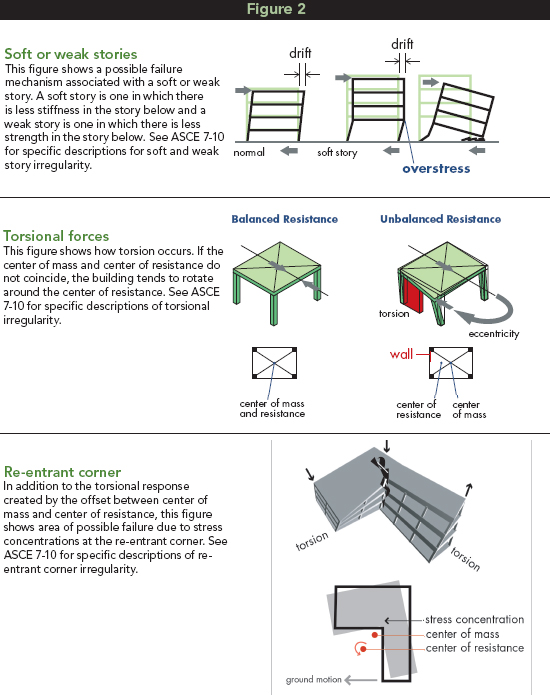Designing for Earthquakes
Buildings with Combinations of Framing Systems
Buildings typically have only one structural system and associated R-factor in each principal axis and vertically. However, in cases where more than one R-factor system is utilized horizontally or vertically, special rules of ASCE 7 apply. In general, design forces and limitations associated with the lower R-factor system are applicable for design in the direction of each principal axis under consideration. There are three common exceptions worthy of mention.
Vertical combinations: Where a building transitions from one system to another vertically through the height of the building structure, system height limits are imposed for the entire structure based on the most restrictive system used. When the upper portion of the structure has a larger R-factor, the upper portion is permitted to be designed for the R-factor associated with that system. The forces imposed from the upper portion onto the lower portion are required to be multiplied (increased) by the ratio of R-factors.
Horizontal combinations: For one- or two-story Risk Category I or II buildings of light-frame or flexible diaphragm construction, the lowest R-factor in any independent line of resistance may be utilized as long as the diaphragm is designed for the lowest R-factor in the overall direction.
Two-stage analysis procedure: This procedure applies when the upper portion of a structure is relatively flexible compared to a rigid lower portion. In this case, the interface between the upper and lower portions is considered to be the base of the upper structure from which structural height of the upper portion is measured. For these structures, the overall building height equals the structural height for the upper portion added to the height of the lower portion. The most common application of the two-stage analysis procedure for wood-frame construction utilizes an upper portion constructed of wood-frame wood structural panel shear walls (structural height limited to 65 ft maximum above the top of the lower portion in SDC D, E, and F) constructed on top of a Type IA concrete podium.
Several requirements must be met in order to comply with requirements of the two-stage analysis procedure:
▶ The lower structure must be at least 10 times as stiff as the upper structure.
▶ The period of the entire structure shall not be greater than 1.1 times the period of the upper portion considered as a separate structure supported at the transition from the upper to the lower portion.
▶ The upper portion shall be designed as a separate structure using the appropriate values of R and ρ.
▶ The lower portion shall be designed as a separate structure using the appropriate values of R and ρ. The reactions from the upper portion shall be those determined from the analysis of the upper portion amplified by the ratio of the R/ρ of the upper portion over R/ρ of the lower portion. This ratio shall not be less than 1.0.
▶ The upper portion is analyzed with the equivalent lateral force or modal response spectrum procedure, and the lower portion is analyzed with the equivalent lateral force procedure.

Source: FEMA
Examples of structural irregularities from FEMA 424 – Design Guide for Improving School Safety in Earthquakes, Floods and High Winds. Another good reference is FEMA 454 – Designing for Earthquakes – a Manual for Architects.
In SDC D, E, and F, the two-stage procedure can be used over a 20-ft-high Type IA podium allowing the overall building construction height of up to 85 ft maximum prescribed in the height and area provisions of the IBC. In addition, to allow the design to structurally achieve height limits associated with height and area provisions, the two-stage procedure allows the upper portion to have the maximum permitted number of stories and area while being considered a separate structure for IBC height and area purposes (with the overall building height measured from the ground).
Nonstructural Component Bracing
Higher performance for critical and essential facilities is accomplished, in part, by designing for higher forces associated with application of the Risk Category Importance Factor and more stringent drift criteria (mentioned previously). It is also achieved through requirements for bracing of nonstructural components within the building. Examples include bracing of fire sprinkler lines, gas supply lines, critical equipment, egress stairways and any other component needed for continued operation of a Risk Category IV structure. While requirements for bracing of nonstructural components are the most extensive for Risk Category IV buildings, they are also applicable in varying degrees to other structures based on factors such as seismic design category, structure type and weight, and importance factor assigned to the component.

Source: FEMA
Examples of structural irregularities from FEMA 424 – Design Guide for Improving School Safety in Earthquakes, Floods and High Winds. Another good reference is FEMA 454 – Designing for Earthquakes – a Manual for Architects.
Conclusion
Years of research and building code development have proven that wood-frame buildings can be designed to meet or exceed the most demanding earthquake requirements. As discussed in this course, wood buildings offer a number of advantages that contribute to their relative good performance in seismic events. Among other things, they tend to be lightweight, reducing seismic forces (which are proportional to weight). Multiple nailed connections in framing members, shear walls and diaphragms offer ductility, meaning they have the ability to yield and displace without sudden brittle fracture. Repetitive members and multiple connections create redundant load paths, which effectively transfer lateral loads. And, when structural panels such as plywood or oriented strand board are properly attached to lumber floor, roof and wall framing, the resulting diaphragms and shear walls offer exceptional seismic force resistance.
For more detailed information on the subjects covered in this CEU, a new version of the American Wood Council’s Code Conforming Wood Design based on the 2018 CCWD is available as a free download at www.awc.org
Endnotes
- U.S. Geological Survey, earthquake.usgs.gov/earthquakes/search/
- U.S. Geological Survey, earthquake.usgs.gov/earthquakes/?source=sitenav
- The January 17, 1994 Northridge, CA Earthquake An EQE Summary Report, March 1994,
lafire.com/famous_fires/1994-0117_NorthridgeEarthquake/quake/00_EQE_contents.htm - Seismic Design with Wood: Solutions for British Columbia Schools. WoodWorks!, 2016,
wood-works.ca/wp-content/uploads/2016-WW.Seismic.final_.LR_.05.05.16.pdf - Seismic Safety Inventory of California Public Schools, California Department of Government Services, 2002,
www.bestfacilities.org/best-home/docuploads/pub/108_SeismicSafetyInventory_CA.pdf - Wood-frame construction in past earthquakes, Rainer, J. Hans, Karacabeyli, E., FPInnovations, www.iitk.ac.in/nicee/wcee/article/2454.pdf
 |
Think Wood is a leading education provider on the advantages of using softwood lumber in commercial, community and multifamily building applications. We introduce innovators in the field to our community of architects, engineers, designers and developers. For support or resources, contact us at info@ThinkWood.com. |








